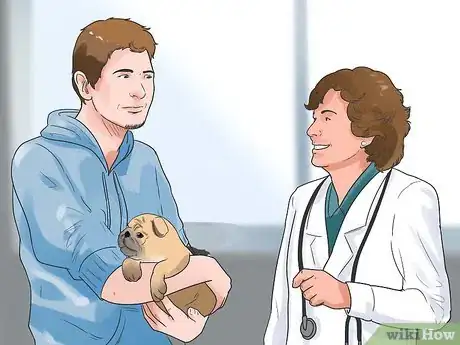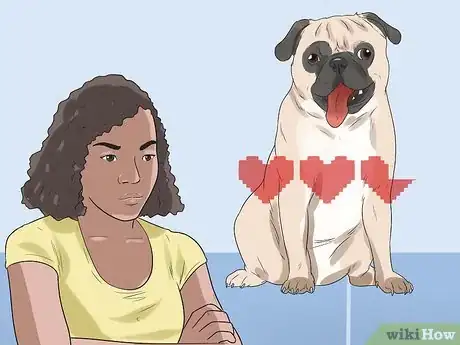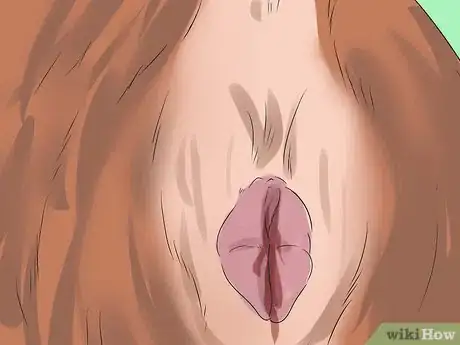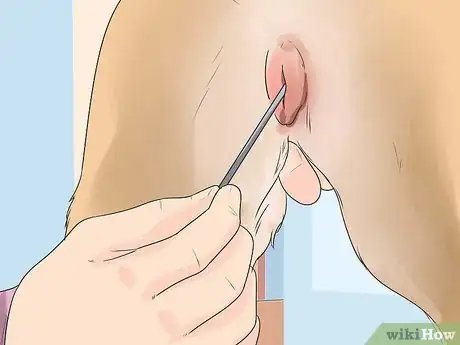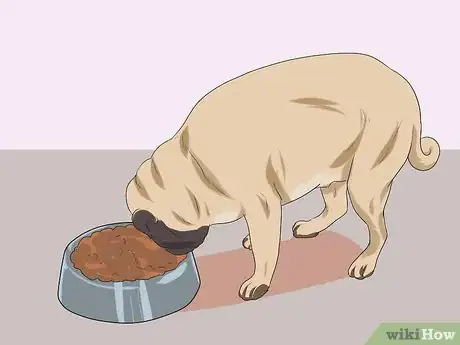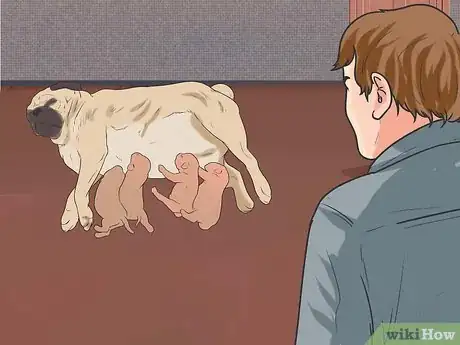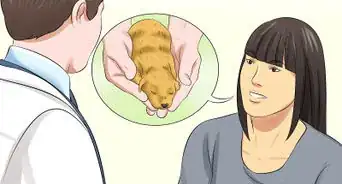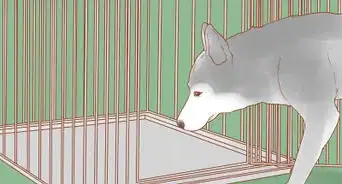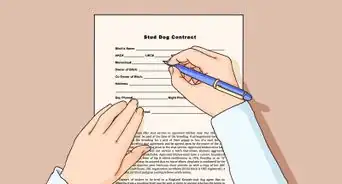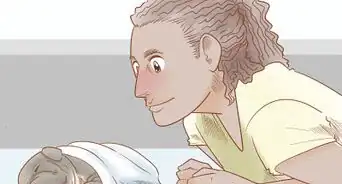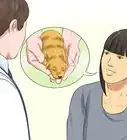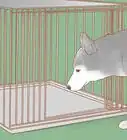This article was co-authored by Pippa Elliott, MRCVS. Dr. Elliott, BVMS, MRCVS is a veterinarian with over 30 years of experience in veterinary surgery and companion animal practice. She graduated from the University of Glasgow in 1987 with a degree in veterinary medicine and surgery. She has worked at the same animal clinic in her hometown for over 20 years.
There are 8 references cited in this article, which can be found at the bottom of the page.
This article has been viewed 105,339 times.
Pugs are one of the most engaging and sassy breed of dogs. Pugs are strong willed at times, but are full of character. If you enjoy your pugs, you may want to have your boy and girl pugs breed with one another. Although this task should not be taken lightly, you can learn the proper way to breed your pug.
Things You Should Know
- Get a test to learn about your pug’s genetic background, check their vaccinations, and consider the pug’s overall health before breeding.
- Introduce a male pug to the female while she is ovulating during her heat, keeping them both on a lead but allowing them to breed freely.
- Once breeding is successful, keep the pregnant pug healthy and care for her puppies until they’re old enough to be adopted.
- Make sure you’re breeding with the intention of producing more healthy pugs, and not making money.
Steps
Deciding to Breed Your Pug
-
1Examine your motivations for breeding. When you begin thinking about breeding your pug, you need to make sure that you are breeding for the right reason. The real reason you should breed your pug is to improve the pug breed overall.
- This means that you want to breed your pug in order to produce more happy, healthy pug specimens.
- You should not breed pugs if you just want to make money or profit in any other way.
-
2Find homes for puppies before you start. Breeding pugs is not a solitary practice. Once your pug produces puppies, the puppies will need some place to go. To ensure that your breeding can go off without a hitch, try to line up homes for the pug puppies ahead of time. You will need to screen possible owners to ensure that they will create a good home for the pug.
- If you have the room, money, and space, you can plan to keep the puppies as long as you want or until you find them a home after they are born. Keep in mind that this cost includes vaccinations, dewormings, parasite controls, and spaying/neutering.
- You can never be sure of how many puppies your pug will have, but make sure you have a decent number of homes, between five to seven, already lined up.
- This preparation will ensure the puppies don’t end up a burden to you and keeps them out of shelters.[1]
-
3Research pug pregnancy. Before you start breeding your pug, you need to make sure you understand what goes into pug pregnancy. You will need to know how to cope with a pregnant pug. This includes how long they stay pregnant, what kind of care she will need when pregnant, and any emergencies that may arise.
- You also need to know how to handle the birth process as well.
- You should also make sure you have a veterinarian you trust and that you can call in case there is an emergency.
Determining If Your Pug Is Right For Breeding
-
1Watch your pug’s temperament. Your pug needs to have a pleasant and enjoyable temperament. The pug you plan to breed with yours should also be well behaved and even tempered. This will ensure their puppies will be good, strong pets.
- If your dog has any emotional or temperament issues, you should rethink breeding him or her. You only want to breed the best pugs you can.
-
2Verify your pug’s genes. Before you breed your pug, you need to have him tested to determine his genetic background. This will test your dog’s bloodline to ensure there are only good qualities in his or her bloodline. If your pug is a registered as a purebred, you can obtain your dog’s bloodline from the American Kennel Club or other registering authority.
- You need to be sure your pug and the pug you are planning to breed with are not directly related in order to prevent any possible genetic defects caused by inbreeding.
-
3Examine your pug’s health. Your pug should be in fine physical shape in order to be bred. This means your pug should be free from any genetic health problems that could be passed down from him or her to the puppies. Take your pug to the veterinarian to get checked out. Common pug diseases that would deter you from breeding your pug include:
- Luxating patellas, also known as 'wobbly kneecaps', which is the excess movement of the kneecap sideways that can cause the hind leg to lock in an extended position.
- Hip dysplasia, which is when the hips are poorly formed so they do not move smoothly in the hip joint, causing the the dog to have a weak back end and lead to early arthritis
- Entropion, which is an inwards turning of the eyelids where the hairs rub on the surface of the eye and cause constant irritation
- Hemivertebra, which is a malformation of the spine bones that causes a physical deformity of the spine
- Cleft palate, which is a separation of the palate of the mouth area, often corrected by surgery at a young age
-
4Check your pug’s vaccination status. Before your pug is mated or bred, you need to ensure he or she is up to date on all necessary vaccinations. This is especially important for your female pug because most vaccines cannot be given during pregnancy.
- Your pug must have the immunity provided by vaccination so she can pass some of these antibodies on to her puppies via her milk, which will give the puppies a low level of protection at a time when their immune systems are weak and developing.
- She should also be up to date with all her parasite treatments as well, including everything from heartworm to roundworms.
- All these things are also important for female pugs because pregnancy suppresses the immune system. This means that any parasite could take advantage of her weakened immunity and breed, which could impact her health and as well as the unborn puppies.
-
5Evaluate your pug’s weight. Your pug should be at a healthy weight in order to be healthy enough to breed. To check your pug’s weight, run your fingers along his or her rib cage. With a gently pressure, you should be able to easily feel the ribs with no rolls of fat in the way.
- Your pug should also have a defined waistline if you look from the side and above. However, there should be enough fat cover that the bones of the hips and pelvis do not stick through.[2]
-
6Consider your pug’s age. When deciding to breed your female pug, you should make sure she is at least 18 months old. This means she should have gone through at least three heat cycles, which will allow her the right amount of time to fully grow and mature. This will make sure that she can handle the rigors of pregnancy and giving birth.
- The male pug should be around 12 to 15 months, since this is how long it would take him to reach full sexual maturity.[3]
- Female pugs should not be bred if they are older than six years old. By this age, she is approaching the dog equivalent of retirement age, which means that the strain of pregnancy could cause organ damage.
- Also, as a general rule, once your pug is bred, she should not have another litters within the following season, so make sure to give her a break in between. Female pugs should also not have more than four litters during her life.
-
7Pick the right male pug. If you don’t have both a female and male pug, you can find your pug a stud, or breed-ready male dog, through different sources. You can buying the services of a male pug, find another local breeder, or find an owner willing to help you out. Make sure you ask to see the male pug’s pedigree and see if he is registered with the Kennel Club, which will allow the puppies to be registered as purebred.
- The Kennel Club does not keep a register of stud dogs, so any information you retain about the male pug has to be done on your own.
- Make sure you meet the male pug before you agree to breeding to ensure that he has a good temperament and physical appearance.
Breeding Your Pug
-
1Watch for her heat. The only time a pug can get pregnant is during her heat. Your female pug will come into heat about twice a year, or roughly once every six months. Her heat period will last about three to four weeks. She will undergo physical changes and her behavior may change some during heat. Male dogs will also be more drawn to her during this time.
- The best way to know for sure if your pug is in heat is to look at her genital area. During her heat, she will have a swollen vulva and release a bloody discharge.[4]
-
2Determine when she is ovulating. Your female pug cannot get pregnant during the whole heat cycle. She can only get pregnant when she is ovulating. This time tends to be approximately day 11 through 14 of her heat cycle.
- This is the time when she wants to have the male’s company as well.
- The range of ovulation can vary depending on the dog.[5]
-
3Have her heat cycle tested. If you don’t want to wait around to check for her heat or guess when she is ovulating, you can have your vet test your pug’s heat cycle so you know exactly when it starts. This will give you the best chance for her to fall pregnant because you will know exactly when she needs to breed.
- The vet may swab her vulva and analyze the cells under a microscope slide to tell exactly what stage of heat she is in and if it's a good time to mate her.
- You can also get an ovulation blood test, which analyzes the levels of hormones in her bloodstream and detect when she is ovulating based on the rise in hormones.[6]
-
4Keep her supervised during heat. During the entire heat cycle, your female pug will be attractive to all male dogs. When she is outside, make sure you keep a close eye on her to ensure that another male dog does not come and mate with her without you knowing about it.
- This is especially important if you let your dog free in a fenced in yard. Male dogs are known to jump fences to get to females in heat.
-
5Introduce the male pug. Once you determine when your female pug is ovulating, have the male pug brought it. When you introduce them, make sure you keep them on a lead. This will keep them safe in case they don’t like each other, making sure you can separate them quickly. Once they meet, they should take to one another.
- The female will not allow the male pug near her until she is ready to breed, but if you have timed it right, this will not be a problem.
- Never forcibly restrain the female pug to get her to submit to the male pug. If the timing is right, she will be a willing participant.[7]
-
6Check for successful mating. You will be able to tell if the breeding was successful around 28 days after the pugs mated. You can do this through a blood test that will show the change in her hormones.
- Your vet can also perform an ultrasound scan a week earlier to check to see if she is pregnant.
- You will also notice a physical change to your pug if she is pregnant, with a slightly protruding belly and nipples on her stomach seeming larger than normal around week two or three after mating.
- By four weeks after mating, her belly will be obvious.[8]
-
7Keep your pug healthy during pregnancy. Take care not to overfeed your pug in the first half of pregnancy. Weight gain at this time can cause problems with giving birth. Instead, stick with regular amounts of her normal food. Once halfway through the pregnancy, switch to a puppy food and feed her little and often, because her stomach will be compressed by the growing puppies.
- Also make sure she has plenty of time to rest, since she will be more tired than normal. However, you should still walk her every day, though at a slower pace than before. This should only change if your vet put on exercise restrictions.
- Pugs are pregnant for an average of 63 days, but anywhere from 60 to 65 days is normal.
- Make sure you have a whelping/birthing box for your pug, which should be big enough for her and any of the puppies and contain a blanket that smells like her.[9]
-
8Take care of the puppies. When the puppies are born, you need to watch them carefully during their first few weeks. They need be clean, warm, continually fed, and gain weight at a healthy rate. This means they should gain about 10% of their weight a day for the first two weeks.
References
- ↑ http://www.akc.org/dog-breeders/learn/guide-to-breeding/
- ↑ https://www.doghealth.com/weight-management/hands-on-guide-to-checking-if-your-dog-is-at-a-good-weight
- ↑ http://www.akc.org/dog-breeders/responsible-breeding/#mate
- ↑ http://www.petpugdog.com/pug-heat-cycle
- ↑ http://www.petpugdog.com/pug-heat-cycle
- ↑ http://www.akc.org/dog-breeders/responsible-breeding/#mating
- ↑ http://www.akc.org/dog-breeders/responsible-breeding/#mating
- ↑ http://www.petpugdog.com/pug-dog-pregnancy
- ↑ http://www.petpugdog.com/pug-dog-pregnancy
About This Article
To breed pugs, you'll need a female pug that's at least 18 months old and no older than 6 years and a male pug that's at least 12 months old. You should also have both pugs genetically tested and examined by a vet to make sure they don't have any health issues or genetic disorders that could get passed onto the pups. After you breed the dogs, you should expect to wait around 60-65 days for the female to give birth. For more tips from our Veterinary co-author, like how to introduce 2 pugs for breeding, scroll down!





